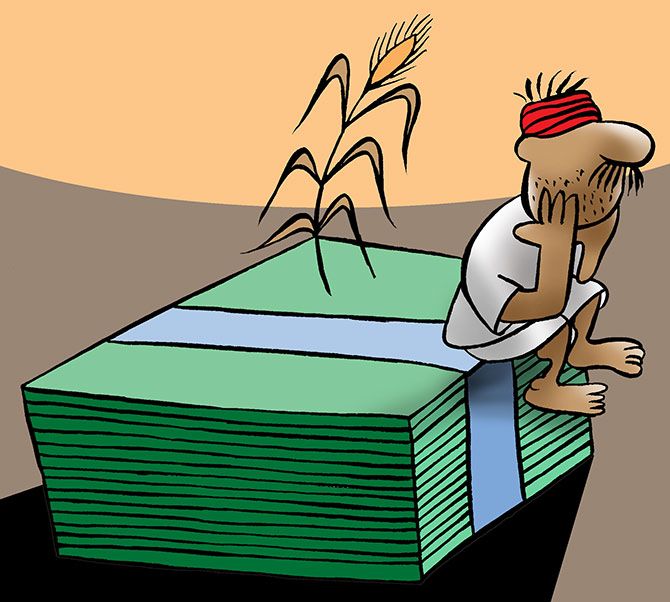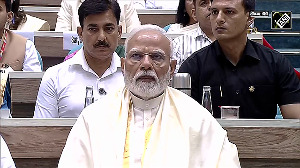Telangana govt currently provides the state's 5.83 million farmers an income support of Rs 4,000 per acre per season, irrespective of the size of their land holding
Illustration: Uttam Ghosh/Rediff.com

Can Telangana’s Rythu Bandhu scheme, which many believe helped K Chandrasekhar Rao (KCR) retain power in the state, be rolled out at the national level?
Under the scheme, the Telangana government currently provides the state's 5.83 million farmers an income support of Rs 4,000 per acre per season, irrespective of the size of their land holding.
To fund this scheme, the state government has earmarked a budget of Rs 12,000 crore in its 2018-19 Budget.
Two principle questions need to be addressed here. First, can landowners be accurately identified across the country and two, what will the scheme's burden be on the exchequer.
Cleaning up the revenue records
On the first, the Telangana scheme was helped by a massive land record modernisation programme carried out by the state administration.
Government officials visited all revenue villages in order to clean up records, allocate titles accurately, create a digital repository and update the pattadar (landholder) passbooks.
“Without this exercise, clear identification of beneficiaries and the assurance that money is reaching the right person wouldn't have been possible,” said a state government official.
In this regard, it is possible that Telangana, along with a few other southern states, is an outlier as there is marked variation across domains on the availability of clean land titles.
For instance, in states like Andhra Pradesh and Telangana, digital record of rights are available for almost all villages, while in Rajasthan, Bihar and Madhya Pradesh the proportion of villages for whom the digital records are available are minuscule, shows a study by PRS Legislative Research.
And while almost Rs 1,930 crore was sanctioned for modernisation of land records, less than 60 per cent of this amount was actually released as of September 2017. And even of this amount, a third remained unspent.
Further, in the other southern states, while digitisation might be high, whether the records are clean or not is another matter, says a state government official. This would take time to resolve, he adds.
These issues suggest that identifying the landowner is likely to be a difficult exercise in most states, including the relatively high-income ones in the south.
Reaching the landless tiller
Then there’s also the issue of the tenant farmer. While cash benefits are received by the landowner, there is the view that this may not trickle down to the tenant farmer or, for that matter, the casual wage labour.
“In Telangana, the benefits of Rythu Bandhu were expected to trickle down in the form of reduction in land rents,” said Ajay Vir Jakhar of Bharat Krishak Samaj, a farmer organisation.
“Getting land records to the level that they reflect actual tenants is a herculean act,” he added.
Fiscal strain
Then there's the fiscal burden of the scheme to take into account.
The total cultivated area in India works out to around 159.4 million hectares.
If one is to assume a cash outflow of Rs 20,000 per hectare per year then the total cost to exchequer works out to around Rs 3.19 trillion says Jakhar.
However, a uniform pan-India strategy is impractical, since the cropping intensity - the ratio of gross cropped area (adding cultivated areas in all seasons) to the net sown area (area which can be cultivated) - varies across states.
“In Punjab, where cropping intensity is approximately 200 cent with about 100 per cent land irrigated, a cash transfer similar to rain-fed farms (such as in Telangana) may have unexpected and unwarranted consequences,” Jakhar adds.
Another estimate by Ashok Gulati, economist at Indian Council for Research on International Economic Relations (ICRIER) pegs the cost for one season at Rs 2 trillion, implying a yearly burden of Rs 4 trillion.
According to a report by Soumya Kanti Ghosh, group chief economic advisor, State Bank of India, if the scheme is implemented on the all India level it would cost the exchequer around Rs 2.7 trillion (based on the net sown area).
Given this huge fiscal burden, Ghosh suggests rolling it out in a few states such as Bihar, Assam, Chhattisgarh, Haryana, Punjab, Jharkhand and Uttarakhand.
One could also target only small and marginal farmers in which case the cost for one season works out to around Rs 70,000 crore or Rs 1.4 trillion for the entire year.












 © 2025
© 2025